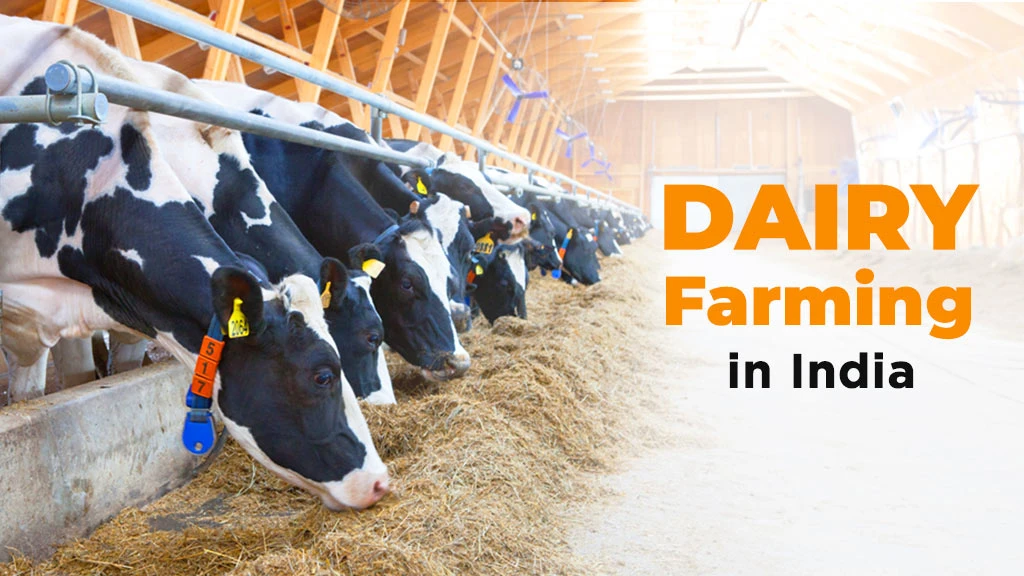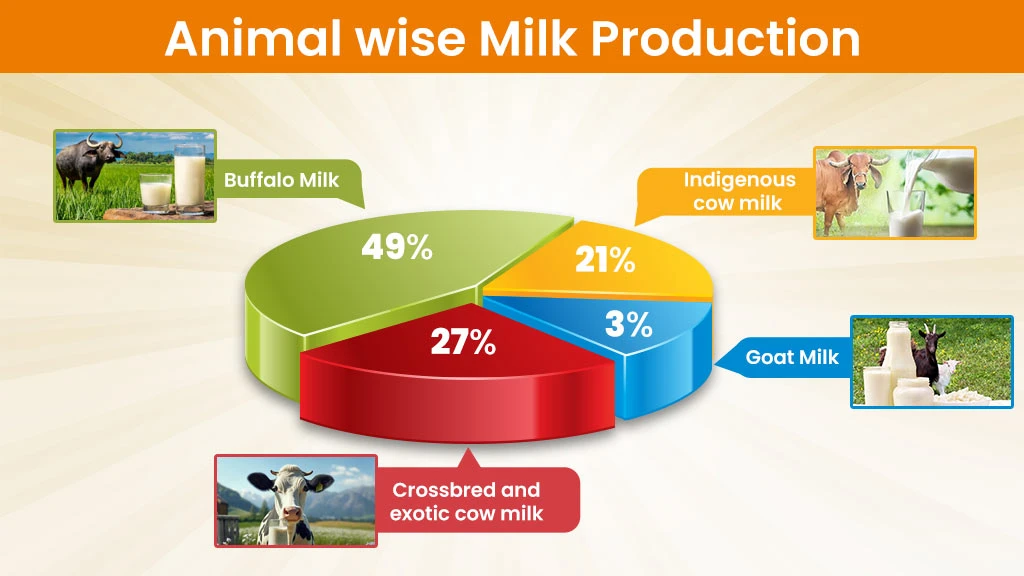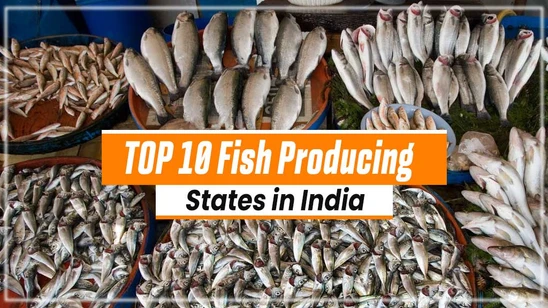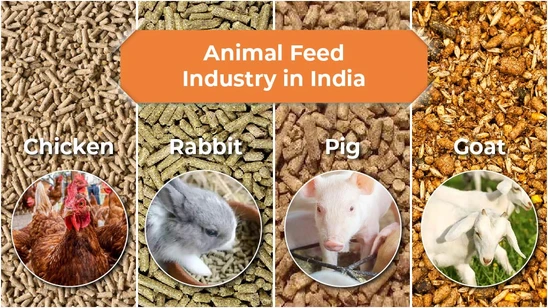Dairy Farming in India: A Window to Farmer’s Prosperity

Table of Contents
- Introduction
- What Changes Operation Flood Brought in India?
- Present Status of Dairy Industry in India
- Animal-wise Milk Production in India
- Importance of Dairy Farming in India
- Growth Drivers of Dairy Industry in India
- Issues in Dairy Farming in India
Introduction
Dairy farming in India is an age-old practice that is in vogue from last 8,000 years when zebu cattle were domesticated for milk production. It is the practice of commercially rearing cattle and buffaloes for the long-term production of milk and its by-products such as cheese, butter, curd, etc. It is either practiced on a farm or at a dairy plant. It is a form of cattle farming in India that involves activities like feeding and managing diary animals, milking and milk processing.
It has always been a small-holder activity in India and milk & milk products have been integral to the Indian society influencing religion, culture, cuisine and economy. In this blog, let us take you through the entire dairy industry landscape in India starting from Operation Flood to present day.
What Changes Operation Flood Brought in India?
The launch of Operation Flood in 1970 under the chairmanship of Dr Verghese Kurien regarded as “Father of White Revolution in India” brought significant changes in the dairy industry in India.
- First, it brought cooperatives into the picture bases on ‘Anand Pattern’
- Second, it facilitated the growth of local dairy businesses in India.
- Third, transformation of dairy industry spreading to far-flung rural areas.
- Fourth, significant increase in the milk production in India from 21.2 million tonnes in 1968 – 69 to 239.3 million tonnes in 2023-24.
Today, India is the number one producer of milk in the world contributing 24% to the global milk production. With the increasing demand for milk and its by-products, the Indian dairy industry is expected to expand from USD 182 billion in 2022 to USD 380 billion by 2028. During 2023-28 the expected annual growth rate (CAGR) is estimated to be 13.2%.
What is the Present Status of Dairy Industry in India?
India’s dairy industry is the largest in the world by virtue of being the world’s largest producer and consumer of milk. The milk production in India in last one decade (2014-15 to 2023-24) has exhibited the average annual growth rate of over 5.50% compared to 2% in the rest of the world.
Below we have provided the present status of Indian dairy industry.
Milk Production: In 2023-24, India produced 239.3 million tonnes (MT) of milk witnessing a growth rate of 4%.
Milk Consumption: India is the world’s largest consumer of milk and dairy products. The per capita availability of milk in India increased to 471 grams/day in 2023-24 from 459 grams/day. It is higher than the world average consumption of 293.7 grams/day.
Top Milk Producing States: Uttar Pradesh is the highest milk-producing state in India, contributing 15.7% of the total milk production. It is followed by Rajasthan, Madhya Pradesh, Gujarat, and Andhra Pradesh.
Milk Exports: India exported 67,572.99 million tonnes of milk valuing INR 2,269.85 crores in 2022-23. Bangladesh, UAE, Saudi Arabia, USA, and Bhutan are the major export destinations of milk.
What is the Milk Production from Different Animals in India?
In India, milk is primarily produced from indigenous cattle and buffaloes. The variety in cattle and buffalo breeds provides a regional variation in milk quality and production.

What is the Importance of Dairy Farming in India?
Dairy Farming is an important sector in the Indian agricultural industry. It is because of the following reasons:
Economic Importance: Dairy sector is the largest sub-sector of Indian agricultural sector. It contributes 5% to the total GDP of the country. Besides, it is a source of livelihood for around 8 crore farmers.
Increasing Domestic Consumption: The domestic consumption of milk has increased over the years. As of 2021, around 49% population consumed milk on daily basis highlighting the increasing demand for milk and milk products. This gives an opportunity to farmers to expand the production possibilities.
Religious and Cultural Significance: Milk and its products is integral to the Indian society. It is integral not only to the religious practices but also central to a wide range of Indian cuisines.
Empowerment of Women: It is one of the primary mediums for women's empowerment in India. As estimated, around 70% of the work on dairy farms is done by women
Wholesome Food: It is a rich, major and cheaper source of nutrients for millions of people of India, including women, children and small & marginal farmers.
What are the Growth Drivers of Dairy Industry in India?
Urbanisation: The urbanisation rate in India will increase from 34% to 37% by 2025.
Conducive Government Policies: Investor friendly government schemes for dairy farming like Animal Husbandry Infrastructure Development Fund (AHIDF), and Rashtriya Gokul Mission.
Disposable Income: Increase in per capita disposable income- USD 1,381 in FY 16 to USD 1981 in FY 20 at a CAGR of 7.5% has increased demand.
Stringent Quality: Harmonisation of food quality guidelines in line with global standards by FSSAI.
Increasing Consumer Base: The percentage of Indian population in the 15-65 years age group increased to 67.45% in 2022 from 55.4% in 1991. The median age is 28.4 years.
Technological Advancements: Technologies like advanced mil testing kits, Bulk Milk Coolers (BMCs), and IoT-enabled systems have increased the possibility of enhancing milk production, its quality and processing efficiency. Besides, the use of automation, sensors and data analytics in dairy farming can enhance overall milk productivity.
What are the Issues in Dairy Farming in India?
The dairy sector in India faces several major challenges despite being one of the largest and fastest-growing segments of the country's agricultural economy. Some of the key challenges include:
Unorganised Sector: Indian dairy sector is largely unorganised. The organised sector only contributes 18 – 20% of the total milk production. As a result, this sector is still not modernised.
Lack of Adequate Infrastructure: Inadequate infrastructure like lack of proper cold storage facilities along with inefficient supply chain & logistics is affecting the Indian dairy industry. As per ASSOCHAM, 3% of the total milk production gets wasted annually.
Shortage of Quality Feed: At present, India is facing a shortage of 11.24% of green fodder, 23.4% of dry fodder, and 28.9% for concentrates. Besides, the high-cost of feed, which accounts for almost 70% of total cost, means that marginal and small farmers cannot afford it. As a result, there is insufficient supply of nutritious feed.
Hygiene & Health Issues: Lack of hygienic environment and inadequate veterinary hospitals another major concern. The National Commission on Agriculture (NCA), 1976 recommends one veterinary institution for every 5,000 cattle units to maintain effective veterinary health care. Furthermore, the insufficient vaccination coverage is exposing the cattle to diseased resulting in financial burden on farmers.
Frequently Asked Questions On Dairy Farming in India
1. What is dairy farming in India?
Dairy farming involves rearing dairy cattle, such as cows and buffaloes, for long-term milk production.
2. Is dairy farming profitable in India?
Yes, dairy farming is profitable in India.
3. Which cow breed is best for dairy farming in India?
Gir, Red Sindhi, and Sahiwal cow breeds are best for dairy farming in India.


Related Blogs















